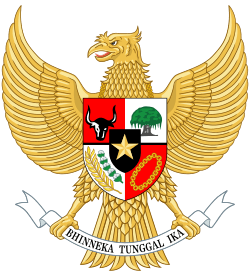Senate of the United States of Indonesia
The Senate of the United States of Indonesia was the upper chamber of the Parliament of the United States of Indonesia which, along with the People's Representative Council of the United States of Indonesia—the lower chamber—comprised the legislature of the United States of Indonesia.
Senate of the United States of Indonesia | |
|---|---|
 | |
| Type | |
| Type | of the Parliament of the United States of Indonesia |
Term limits | None |
| Leadership | |
Speaker | |
Deputy Speaker | |
| Seats | 32 |
| Constitution | |
| Constitution of the United States of Indonesia | |
The composition and powers of the Senate were established by Section Two of the Constitution of the United States of Indonesia (RUSI). The Senate was composed of senators, each of whom represented a single state or autonomous entity of the RUSI in its entirety. Each state, regardless of its population size, was equally represented by two senators. At the time of its formation, there were 32 members in the senate, but prior to the dissolution of the senate, there were only 27 members left, with the speaker of the senate not being counted as the member of the senate (according to the article 85.3 of the constitution). Most of the members that left the senate were local monarchs who had to serve in their respective kingdom (Muhammad Kaharuddin III and Sujadi).
History
With the recognition of the sovereignty of Indonesia on 27 December 1949, the Republic of Indonesia was included in the United States of Indonesia, which comprised all the territory of the former Dutch East Indies with the exception of Netherlands New Guinea, sovereignty over which it was agreed would be retained by the Netherlands until further negotiations with Indonesia.[1]
The Constitution of the United States of Indonesia came into force on 27 December 1949. In its first article, the constitution stated that the sovereignty of Indonesia shall be implemented together with the People's Representative Council and the Senate.[2]
Based on the constitution, on 16 February 1950, the Senate of the United States of Indonesia was formed, and its members were sworn in on the same day.[3]
Speaker and Deputy Speaker
Election
The election for the speaker and deputy speaker of the Senate was held on 17 February 1950, with Ki Hadjar Dewantara (Republic of Indonesia), Djaidin Purba (East Sumatra), M. A. Pellaupessy (East Indonesia), Tadjuddin Noor (Southeast Kalimantan) and Teuku Muhammad Hasan (Republic of Indonesia) as the candidates. Pellaupessy and Hasan came out as the winner and runner-up of the election, and both were elected as the speaker and the deputy speaker of the Senate.[4]
| Candidates | Constituency | Votes | |||
|---|---|---|---|---|---|
| M. A. Pellaupessy | East Indonesia | 14 | |||
| Teuku Muhammad Hasan | Republic of Indonesia | 12 | |||
| Ki Hadjar Dewantara | Republic of Indonesia | 1 | |||
| Tadjuddin Noor | Southeast Kalimantan | 0 | |||
| Djaidin Purba | East Sumatra | 0 | |||
| Abstentions | 1 | ||||
| Source: Tim Penyusun Sejarah 1970, p. 98 | |||||
The speaker and the deputy speaker began to lead the meetings of the Senate since 27 February 1950. Prior to that date, the meetings of the senate was led by the oldest member of the Senate. The oldest member of the Senate at the time was RAA Sujadi (61).[5]
Membership
Requirements
According to Article 82 of the constitution, the senator shall be at least 30 years old and have never had his or right of election revoked.[6] The senator should also show his credentials from his state.[7]
Composition
The constitution stipulated that the Senate consists of 32 senators, with 2 senators from each state and region.[8] In reality, only 28 were installed on the afternoon of 16 February 1950. Two senators, Raden Hanan and Anang Abdul Rivai were installed on 20 February 1950 and 5 March 1950. Out of the 32 senators, four officially withdraw from the Senate (Machmud, R. Abdurrasid, Roeslan Wongsokoesoemo, Muhammad Kaharuddin III).[9]
As the speaker of the senate did not count as a member of the Senate, the State of East Indonesia practically has no representation in the Senate. There was no replacement for M.A. Pellaupessy who had been elected as the Speaker and Sultan Kaharuddin III who had withdrawn from the Senate.
Work accomplished
In its six months, there was only one out of the seven federal laws and thirty emergency laws that were passed by the government with the approval of the Senate. The law was the Law No. 7/1950 regarding the enactment of the Provisional Constitution of 1950. Out of the thirty emergency laws, there were twelve emergency laws that were passed by reviewing the consideration from the Senate.[10]
Bibliography
- Djuana, Mohammad; Sulwan (1956), Tata-negara Indonesia:dengan bagian-umum (Government of Indonesia) (in Indonesian), Jakarta: GroningenCS1 maint: ref=harv (link)
- Hilmi Syatria (Ed) (1995), Gedung MPR/DPR RI: Sejarah dan Perkembangannya [MPR/DPR RI Building: History and Development] (PDF) (in Indonesian), Jakarta: Tim Panitia Penerbitan Buku Gedung MPR/DPR RI, ISBN 979-8776-003CS1 maint: extra text: authors list (link) CS1 maint: ref=harv (link)
- Tim Penyusun Sejarah (1970), Seperempat Abad Dewan Perwakilan Rakyat Republik Indonesia [A Quarter Century of the People's Representative Council of the Republic of Indonesia] (PDF) (in Indonesian), Jakarta: Sekretariat DPR-GRCS1 maint: ref=harv (link)
- Sri Bntang Pamungkas (ed) (1999). Konstitusi Kita dan Rancangan UUD45 Yang Disempurnakan (in Indonesian). Jakarta: Partai Uni Demokrasi Indonesia.CS1 maint: extra text: authors list (link) CS1 maint: ref=harv (link)
References
- Ricklefs 2008, p. 373
- Sri Bntang Pamungkas 1999, p. 84
- Tim Penyusun Sejarah 1970, p. 96
- Tim Penyusun Sejarah 1970, pp. 98-99
- Tim Penyusun Sejarah 1970, p. 99
- Djuana & Sulwan 1956, p. 95
- Djuana & Sulwan 1956, p. 95
- Djuana & Sulwan 1956, p. 97
- Tim Penyusun Sejarah 1970, pp. 584-585
- Tim Penyusun Sejarah 1970, pp. 129-131